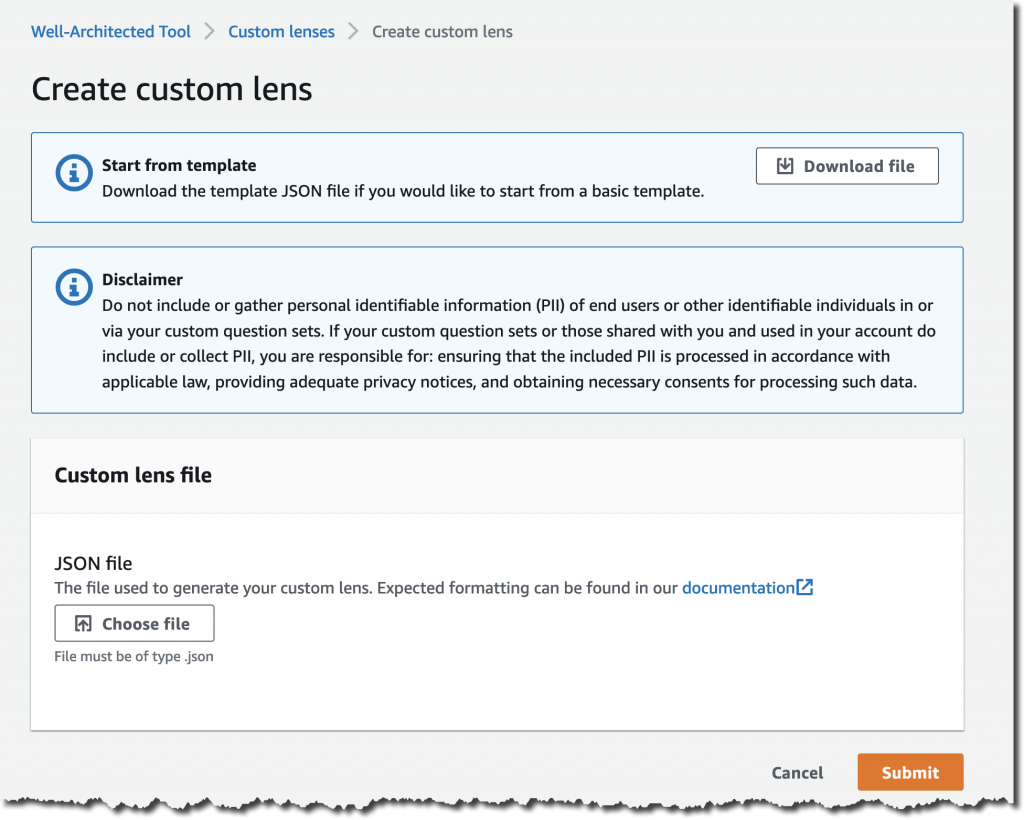AWS News Blog
Announcing AWS Well-Architected Custom Lenses: Extend the Well-Architected Framework with Your Internal Best Practices
|
|
We launched the AWS Well-Architected Framework back in 2015 to help you review workloads against architectural best practices, and across pillars such as operational excellence, security, reliability, performance efficiency, and cost optimization. In 2017, we extended the framework with the concept of “lenses” to optimize specific workload types such as the Serverless Lens, the SaaS Lens, and the Foundational Technical Review (FTR) Lens for APN Partners. In 2018, we launched the AWS Well-Architected Tool, a self-service tool designed to help you review AWS workloads at any time, without the need for an AWS Solutions Architect.
Today, I’m happy to announce the general availability of AWS Well-Architected Custom Lenses, a new feature of the AWS Well-Architected Tool that lets you bring your own best practices to complement the existing framework based on your industry, operational plans, and internal processes. Custom Lenses provide a consolidated view and a consistent way to measure and improve your workloads on AWS without relying on external spreadsheets or third-party systems.
In addition to AWS Well-Architected Lenses, now you can create and share custom lenses and include them in your workload reviews, ultimately tailoring the review to your organizational needs. For example, you could define a custom lens to review your workloads against PCI compliance, SOC 2 compliance, or other national or industry regulations. As an AWS Partner, you might include ad-hoc best practices in your custom lenses when reviewing workloads with customers from different industries and segments, ultimately making the review process easier, faster, and more comprehensive.
How to Define a new Custom Lens
You author a new custom lens by editing a JSON preset template, where you define questions, choices, helpful resources, improvement plans, and risk rules.
Here’s how it works: download the template from the AWS Well-Architected Tool, work on it locally, and then re-upload it.

The JSON structure is composed of multiple pillars. Each pillar might contain multiple questions, each with its own choices and risk rules.
Your JSON file will look like this:
{
"schemaVersion": "2021-11-01",
"name": "My Test Lens",
"description": "This is a description of my test lens.",
"pillars": [
{
"id": "pillar_red",
"name": "Red Pillar",
"questions": [
{
"id": "pillar_1_q1",
"title": "How do you get started with this pillar?",
"description": "Optional description.",
"choices": [
{
"id": "choice1",
"title": "Best practice #1",
"helpfulResource": {
"displayText": "This is helpful text for the first choice.",
"url": "https://aws.amazon.com"
},
"improvementPlan": {
"displayText": "This is text that will be shown for improvement of this choice."
}
},
{
"id": "choice2",
"title": "Best practice #2",
...
}
],
"riskRules": [
{
"condition": "choice1 && choice2",
"risk": "NO_RISK"
},
{
"condition": "choice1 && !choice2",
"risk": "MEDIUM_RISK"
},
{
"condition": "default",
"risk": "HIGH_RISK"
}
]
}
]
...
},
...
]
}Once you’re ready to submit your JSON file, proceed with the upload.
And don’t worry about making it perfect on the first try. You’ll be able to improve it and add new versions.
AWS Well-Architected Custom Lenses in Action
You find the list of custom lenses and their latest version in the new Custom Lenses section.

Each custom lens has an owner and can be shared with multiple AWS accounts too.
Before using this new custom lens in a workload review, you’ll need to publish it and assign it a version.

Select Publish lens and provide a version name such as 1.0.

Now you can create a new workload review and apply both AWS-owned lenses and your own custom lenses, in addition to the main framework.

During the workload review, you will go through each pillar and questions of the custom lens, using the same user interface provided by the AWS Well-Architected Tool.

Last but not least, you can share your custom lens with other AWS Identity and Access Management (IAM) principals such as AWS accounts, IAM users, and IAM roles.

Available Today at No Charge
Custom Lenses are available today in all AWS Regions where the AWS Well-Architected Tool is available, at no cost. You can define up to five custom lenses and share them across AWS Accounts, in addition to the existing Well-Architected Framework and AWS-owned Lenses.
Check out the technical documentation here.
We’re looking forward to hearing your feedback and iterating quickly to improve the authoring and sharing experience based on your needs.
— Alex
